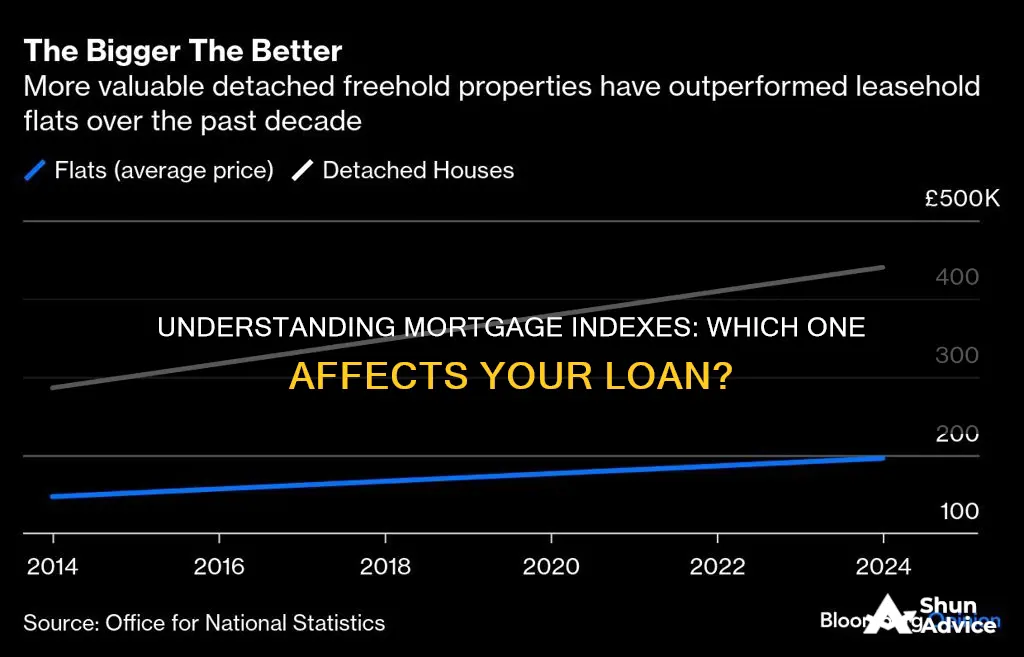
If you have an adjustable-rate mortgage, the interest rate will change over time. This rate is determined by the index and the margin. The index is an interest rate that fluctuates with the market, and the margin is a number set by your lender when you apply for your loan. The choice of mortgage index can impact what a lender charges the borrower, as mortgages are assessed at designated intervals. The index your loan will use is decided by the lender when you apply for the loan, and this choice generally won't change after closing.
| Characteristics | Values |
|---|---|
| Definition | The index is an interest rate that fluctuates with general market conditions. |
| Adjustable-rate mortgage | The index to which an adjustable-rate mortgage (ARM) is tied can make a difference over the life of the mortgage. |
| Index choice | The lender decides which index the loan will use when the borrower applies for the loan. |
| Index change | The index choice generally won't change after closing. |
| Index examples | The prime rate, the one-year constant maturity treasury (CMT) value, the one-month, six-month, and 12-month LIBORs, the MTA index, the federal funds rate, the MND Rate Index. |
| Index tracking | The MND Rate Index is a good way to follow day-to-day movement in mortgage rates. |
What You'll Learn

What is an adjustable-rate mortgage (ARM)
An adjustable-rate mortgage (ARM) is a type of home loan with a variable interest rate. In other words, the interest rate on an ARM will change periodically. Unlike fixed-rate mortgages, where the interest rate remains the same for the duration of the loan, the interest rate on an ARM is typically fixed for a certain period at the beginning of the loan, after which it begins to adjust periodically, usually at yearly or monthly intervals. This initial fixed-rate period can range from the first five, seven, or ten years of the loan. The interest rate during this period is often called the "intro" or "teaser" rate. Once this period ends, the interest rate can go up or down based on changes in the benchmark index tied to the ARM, resulting in unpredictable monthly mortgage payments that are harder to factor into your budget.
The benchmark index specified in an ARM agreement is a key factor in determining the interest rate and is the starting point for future interest rate adjustments. The index is an interest rate that fluctuates with general market conditions. The London Interbank Offered Rate (LIBOR) was a typical index used in ARMs until October 2020, when it was replaced by the Secured Overnight Financing Rate (SOFR) to increase long-term liquidity. Other common mortgage indexes include the prime lending rate, the one-year Constant Maturity Treasury (CMT) value, the one-month, six-month, and 12-month LIBORs, and the MTA index. The choice of mortgage index can impact the interest rate charged by the lender, as mortgages are assessed at designated intervals, which could be at six-month, one-year, or two-year intervals.
In addition to the index, the interest rate of an ARM also depends on a spread called the ARM margin. The margin is a fixed percentage that the lender adds to the current benchmark rate to determine the ARM interest rate. The margin is set by the lender when the loan is applied for and is usually included in the loan agreement. It remains constant throughout the loan and can vary between different lenders. Other factors that influence the margin include the borrower's creditworthiness, credit score, and credit history.
ARMs generally come in three forms: Hybrid, interest-only (IO), and payment option. Hybrid ARMs offer a mix of fixed- and adjustable-rate periods. During the fixed-rate period, the interest rate remains the same, after which it begins to float at a predetermined time. This information is typically expressed in two numbers, with the first number indicating the length of the fixed-rate period and the second referring to the duration or adjustment frequency of the variable rate. ARMs typically have caps that limit how much the interest rate and/or payments can rise per year or over the lifetime of the loan, providing some protection from large interest rate swings.
Finding Mortgage Records: A Comprehensive Guide
You may want to see also

How does the index of an ARM work
An ARM, or adjustable-rate mortgage, is a loan with an interest rate that changes over time. The interest rate of an ARM is tied to a specific benchmark, known as the ARM index, with rate changes based on the movement of the benchmark. The ARM index is an interest rate that fluctuates with general market conditions.
The choice of mortgage index can impact what a lender charges the borrower, as mortgages are assessed at designated intervals. The mortgage will specify when the adjustments to the interest rate will be made—for example, at six-month, one-year, or two-year intervals. At that time, the lender will recalculate the interest using the index and the margin to determine the new figure. The margin is the number of percentage points added to the index by the mortgage lender to set your interest rate on an ARM after the initial rate period ends. The margin is set in the loan agreement and won't change after closing. The fully indexed rate is equal to the margin plus the index.
Some common mortgage indexes include the prime lending rate, the one-year constant maturity treasury (CMT) value, the one-month, six-month, and 12-month LIBORs, as well as the MTA index, which is a 12-month moving average of the one-year CMT index. The index that an adjustable-rate mortgage is tied to is an important factor in the choice of a mortgage. For example, if a borrower believes that interest rates will rise in the future, the MTA index would be a more economical choice than the one-month LIBOR index because of its moving average calculation, which creates a lag effect.
Understanding Mortgage Affordability: A Guide to Homeownership
You may want to see also

How to choose an index for an ARM
An ARM (adjustable-rate mortgage) is a type of mortgage where the interest rate fluctuates periodically based on general market conditions. The index is an interest rate that fluctuates with these market conditions. The choice of mortgage index can impact what a lender charges the borrower, as mortgages are assessed at designated intervals.
There are several indexes that can be used as a base interest rate to compute adjustable-rate mortgage interest. Here are some of the most popular:
- Prime rate: This is the most desirable interest rate charged by banks to their most favourable clients. It is typically used in the pricing of short- and medium-term loans, or for adjustments at set intervals on long-term loans.
- LIBOR (London Interbank Offered Rate): This is a global index used by investors who operate internationally. It is based on the interest rate charged among London-based banks for borrowing transactions.
- MTA (Monthly Treasury Average) Index: This is the average of the monthly yields of U.S. Treasury securities adjusted to a constant maturity over one year.
- COFI (11th District Cost of Funds Index): This is a monthly weighted-average interest rate paid by the 11th Federal Home Loan Bank.
When choosing an index for an ARM, it is important to consider the potential risks and benefits of each option. For example, the LIBOR index offers flexibility with intervals that can be one month, three months, six months, or one year. On the other hand, the MTA index would be a more economical choice than the one-month LIBOR index if interest rates are expected to rise in the future due to its moving average calculation, which creates a lag effect.
It is also beneficial to be familiar with the wide array of indexes available, their advantages and disadvantages, and how they respond to varying economic conditions. Additionally, pay attention to the margin offered by different lenders, as it can vary and will impact your overall interest rate.
Strategies to Overcome Mortgage Debt Problems
You may want to see also

How to track the index rate
The index rate of a mortgage is an interest rate that is tied to a specific benchmark, with changes based on the movement of the benchmark. The index rate is also known as an adjustable-rate mortgage or ARM. The index rate of a mortgage can be tracked through various tools and indices. Here are some ways to track the index rate:
- Mortgage News Daily (MND) Rate Index: The MND Rate Index is widely recognized as the industry standard for tracking daily changes in mortgage rates. It is based on real-time adjustments in lender rate sheets, making it highly accurate and timely. The index is typically updated once a day and is available on weekdays around 4 PM EST.
- ICE U.S. Residential Mortgage Rate Lock Indices: This index tracks the average rate at which new residential home loans are locked in each day. The data is calculated daily for all U.S. bank business days and can be accessed through the ICE Index Platform and direct data feeds.
- National Average Indices: Some websites provide a national average index, calculated daily, to help individuals track current mortgage rates when purchasing or refinancing their homes. This data is based on actual rate offerings from various lenders, ensuring accuracy and representation of market trends.
- Surveys and News Sources: In addition to indices, it is beneficial to follow surveys from entities such as Freddie Mac and MBA. Staying informed through newsletters, market analysis, and mobile apps can help individuals track underlying trends and understand the reasons behind rate changes.
By utilizing these tools and resources, individuals can effectively track the index rate of their mortgage and make informed decisions regarding their financial plans. It is important to stay updated on mortgage rate movements, especially with the dynamic nature of adjustable-rate mortgages.
Mortgage Closing Problems: Solutions for a Smooth Transaction
You may want to see also

What is the difference between the index and margin of an ARM
An adjustable-rate mortgage (ARM) is a type of mortgage in which the interest rate applied to the outstanding balance varies throughout the loan's life. The index and margin are two crucial terms that determine the monthly payment for an ARM.
The index is an interest rate that fluctuates periodically based on general market conditions. It is a benchmark rate that lenders use as a guide for determining the interest rate on the loan. Common benchmark rates used for the ARM include the London Interbank Offered Rate (LIBOR), the lender's prime rate, and various types of U.S. Treasuries. The index rate can increase or decrease, causing a change in the borrower's interest rate and monthly payment.
The margin, on the other hand, is a fixed percentage or number of points added to the index to calculate the interest rate. It is set by the lender when the loan is applied for and remains constant throughout the loan term. The margin can vary between different lenders, and it is important to pay attention to it when shopping for a loan.
To calculate the interest rate for an ARM, the index rate and the margin rate are summed up. For example, if the index rate is 2.5% and the margin is 2%, the total interest rate would be 4.5%. Understanding the relationship between the index and margin is essential to comprehending how your mortgage payments may fluctuate.
Finding Mortgage Interest Paid: A Guide to Your Payments
You may want to see also
Frequently asked questions
The lender decides which index your mortgage will use when you apply for the loan. This choice generally won't change after closing. Some common mortgage indexes include the prime lending rate, the one-year constant maturity treasury (CMT) value, the one-month, six-month, and 12-month LIBORs, as well as the MTA index.
A mortgage index is a benchmark interest rate to which an adjustable-rate mortgage (ARM) is tied. The interest rate on an ARM with its index is known as a fully indexed interest rate. The choice of mortgage index can impact what a lender charges the borrower as mortgages are assessed at designated intervals.
The mortgage will specify when the adjustments to the interest rate will be made, which could be at six-month, one-year, or two-year intervals, for example. The MND Rate Index is a good way to follow day-to-day movement in mortgage rates.







